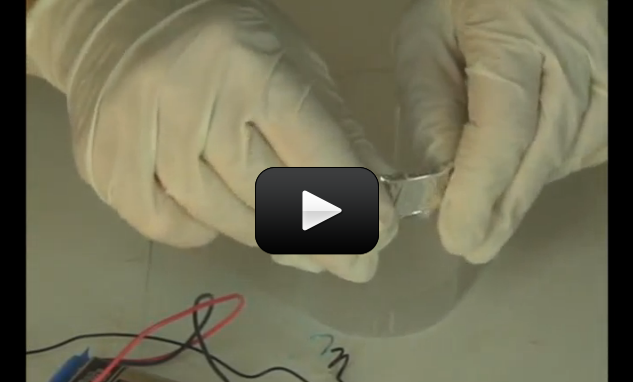In this lab, we’re going to investigate the wonders of electrochemistry. Electrochemistry became a new branch of chemistry in 1832, founded by Michael Faraday. Michael Faraday is considered the “father of electrochemistry”. The knowledge gained from his work has filtered down to this lab. YOU will be like Michael Faraday. I imagined he would have been overjoyed to do this lab and see the results. You are soooo lucky to be able to take an active part in this experiment. Here’s what you’re going to do…
You will be “creating” metallic copper from a solution of copper sulfate and water, and depositing it on a negative electrode. Copper is one of our more interesting elements. Copper is a metal, and element 29 on your periodic table. It conducts heat and electricity very well.
Many things around you are made of copper. Copper wire is used in electrical wiring. It has been used for centuries in the form of pipes to distribute water and other fluids in homes and in industry. The Statue of Liberty is a wonderful example of how beautiful 180,000 pounds of copper can be. Yes, it is made of copper, and no, it doesn’t look like a penny…..on the surface. The green color is copper oxide, which forms on the surface of copper exposed to air and water. The oxide is formed on the surface and does not attack the bulk of the copper. You could say that copper oxide protects the copper.
[am4show have=’p8;p9;p25;p52;p91;’ guest_error=’Guest error message’ user_error=’User error message’ ]
Our bodies use copper to our advantage, but in a proper form that is not toxic. Too much copper will make you sick and could kill you. Remember…don’t eat your chemistry set!
Materials:
- Carbon rod (MSDS)
- Copper sulfate (CuSo4) (MSDS)
- Aluminum foil
- 9V battery with clip
- 2 wires
- Disposable cup
- Water
You are going to make a saturated solution of copper sulfate (CuSO4) in water. Pour a measuring spoon of granulated copper sulfate in the measuring cup of water. Stir well. Continue adding a spoonful and stirring until no more crystals will go into solution. The solution is saturated when no more crystals will dissolve and there are undissolved crystals at the bottom of the container.
C1000: Experiment
Download Student Worksheet & Exercises
Here’s what’s going on in this experiment:
CuSO4 + H2O (Copper sulfate is added to water)
CuSO4 + H2O –> Cu2+ + SO42- (Copper sulfate plus water yields positively charged carbon ion and negatively charged sulfate ion)
When mixed with water, copper sulfate dissociates into copper and sulfate ions. Notice that the ions, now separated, take on negative and positive charges.
Next, 9V of electricity is passed through the solution with an electrode of carbon and an electrode of aluminum foil inserted into the solution. As electricity flows from one electrode to another, the copper ions, being positively charged, are attracted to the negative electrode. You can confirm this in two ways. One, if litmus paper, held close to an electrode, turns blue, that is the negative electrode. The other way is to just follow the negative lead from the battery to the negative electrode.
As the process moves along, the negative electrode gains copper ions. Evidence of this is seen on the surface of the electrode.
Here’s the breakdown of the entire process:
When the copper sulfate (CuSO4) mixed with water (H2O), the copper sulfate dissociated:
CuSO4 –> Cu2+ + SO42-
When power is added to the solution, the copper ions move toward the negative cathode (carbon rod) and take electrons from it, forming solid copper right on the electrode:
Cu2++ 2e– –> Cu(s)
On the positive anode (the aluminum foil), you’ll see bubbles instead of a solid forming. The anode attracted electrons from the water molecule to form oxygen bubbles:
6H2O –> O2 + 4H3O+ + 4e–
Let’s put these two reactions together to get the overall reaction of:
2Cu2+ + 6H2O –> 2Cu + O2 + 4H3O+
Note the difference between galvanic cells and electrolytic cells: galvanic use spontaneous chemical reactions (like in a car battery) to generate electricity, and electrolytic cells use electricity to make the chemical reaction to occur and move electrons to move in a way they would go on their own (like in this experiment).
Clean up: Clean everything thoroughly after you are finished with the lab. After cleaning with soap and water, rinse thoroughly. Chemists use the rule of “three” in cleaning glassware and tools. Rinse three times, wash with soap, rinse three times.
Wipe off the carbon rod to remove the copper. The aluminum goes in the trash, but the solution and solids at the bottom cannot. The liquid contains copper, a toxic heavy metal that needs proper disposal and safety precautions. Another chemical reaction needs to be performed to remove the heavy metal from the copper sulfate. Add a thumb sized piece of steel wool to the solution. The chemical reaction will pull out the copper out of the solution. The liquid can be washed down the drain. The solids cannot be washed down the drain, but they can be put in the trash. Use a little water to rinse the container free of the solids.
Place all chemicals, cleaned tools, and glassware in their respective storage places.
Dispose of all solid waste in the garbage. Liquids can be washed down the drain with running water. Let the water run awhile to ensure that they have been diluted and sent downstream.
Going Further
Here is a link to information about making your own geode (crystal lined rock) of copper sulfate crystals:
http://chemistry.about.com/od/growingcrystals/ht/geode.htm
[/am4show]


Oops! This is one that my programmer skipped when we upgraded the videos. I’ll have them fix it right away! Sorry about that…
The video won’t play for us. Can you help?
Thanks